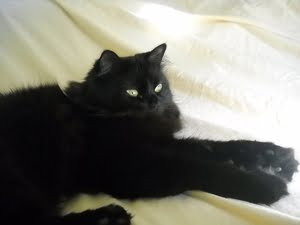Feline obesity is a common health problem. The kind of food a cat eats is largely to blame. Dry kibble is loaded with calories in the form of filler corn, rice, and other carbohydrates. These extra calories are stored as fat in the carnivorous cat’s body, leading to feline obesity.
The negative effects of feline obesity accumulate over time in a cat’s body. Diabetes, urinary tract disease, osteoarthritis, kidney disease, and liver disease are five of the most common obesity-related health problems that plague fat cats.
Feline Diabetes
What it is: Feline diabetes is an obesity-related disease that occurs when a cat’s body no longer produces the proper amount of insulin. Left untreated, feline diabetes can be fatal.
Symptoms: The cat may display an increase in appetite, thirst, or need to urinate. He may lose weight, become lethargic, and display weakness in his back legs. Blood and urine tests are needed to confirm a diabetes diagnosis.
Treatments: The disease is often manageable with daily insulin injections. Owners can learn to do this at home.
Prevention: Combat obesity by feeding your cat a wet food diet that is high in protein, fat, and water. Minimize his intake of the excessive carbohydrates found in dry cat food. Encourage playtime and activity.
Feline Urinary Tract Disease
What it is: Feline urinary tract disease is an obesity-related problem that can occur in the form of cystitis, urinary stones, urinary crystals, and urinary obstruction. These conditions are painful and, left untreated, can be fatal.
Symptoms: The cat may display an increase or decrease in urinary frequency. He may meow in pain, or lick the urinary area in attempt to stop the pain. He might not be able to make it to the litter box in time.
Treatment: A cat with urinary symptoms must see a veterinarian. Changes in diet can help alter his urinary pH. Subcutaneous fluids (administered with a needle under the skin) can help hydrate the cat and flush out his bladder. Catheterization and/or surgery are necessary for a urinary obstruction. Don’t wait to seek help!
Prevention: Combat obesity and increase hydration by feeding the cat a wet food diet. Provide him with clean litter areas to minimize bacterial exposure.
Feline Osteoarthritis
What it is: Feline osteoarthritis is an obesity-exacerbated disease in which joint cartilage deteriorates. Raw bones and nerves rub together when the cat moves, causing inflammation and pain.
Symptoms: Lameness, stiffness, unsteady gait, and a general reluctance to move.
Treatment: Weight loss can help take some of the pressure off, but it must be done gradually! (See Feline Fatty Liver Disease, below.) NSAIDS, glucosamine chondroitin, and/or surgery may be prescribed.
Prevention: Arthritis can be caused by injury or heredity. Obesity puts pressure on the joints and aggravates the pain. Combat obesity by not allowing your cat to get fat in the first place. Feed him a low carbohydrate, high protein, high fat, water-rich diet.
Feline Kidney Disease (chronic)
What it is: Chronic kidney failure is an obesity-related disease in which the kidneys slowly lose their ability to flush toxins from the cat’s blood.
Symptoms: Increased thirst and urination, loss of appetite, vomiting, and dehydration.
Treatment: Subcutaneous fluids may be given to rehydrate the cat and help his kidneys flush toxins. Owners can learn to administer fluids at home.
Prevention: Combat obesity and dehydration by feeding the cat a wet food diet. The water in wet food will help his kidneys stay healthy. Wet food diets are imperative for cats who have already been diagnosed with kidney disease.
Feline Fatty Liver Disease
What it is: Feline Fatty Liver Disease (feline hepatic lipidosis) is an obesity-related disease in which a fat cat suddenly loses a lot of weight. The liver works extra hard to compensate for the weight loss by releasing stored fat as energy. The release of stored fat overtaxes the liver and can lead to liver failure. This is why feline weight loss should always be gradual!
Symptoms: Sudden weight loss, depression, lethargy, and stress. If your cat demonstrates any of these symptoms, get him to the vet immediately!
Treatment: The cat must be force-fed a nutrient-dense diet to make up for nutritional losses and damage to his liver. This may entail the use of a syringe or feeding tube.
Prevention: Combat obesity by feeding your cat a high protein, low carbohydrate diet that is water-rich. If the cat loses his appetite, find ways to entice him back into healthy eating, before it’s too late.
Summary
Obesity takes its toll on a cat’s pancreas, liver, kidneys, urinary tract, and skeletal system. It negatively affects other bodily systems, as well. Feline obesity can cheat a cat out of years of high-quality life. Serving low-carbohydrate, nutrient-rich, wet cat food is one way to combat feline obesity and eliminate obesity-related disease.


